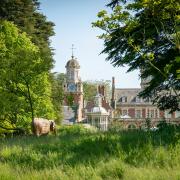Liz Ferretti meets Ian Sedge, sign painter, designer and co-founder of Suffolk Heritage Skills, whose distinctive style is making its mark

Painting and drawing software for the computer are useful tools, but they can’t give you the bespoke, hand-crafted look that Ian Sedge prides himself on.
Ian’s designs and branding have a stylish, instantly recognisable feel, but they also highlight the unique qualities of the business they are promoting. His drawings are full of exquisite detail. A mouse on a house sign is caught for an instant, sniffing the air, looking as though it could scurry off its upturned pot and out of sight in an instant.
“My design ideas are certainly heritage-based,” Ian explains, “but while they hark back to something older, my work is not simply about making something that is pretty, this is design with a purpose. Developing a brand for a business is about attracting custom and generating income. The attention to detail in the branding is a reflection of how these businesses want to be seen by their customers.
“I spend time with a client, so that I understand their business. It’s worth it because the end result is unique to the client.” It’s a world away from impersonal, mass-produced design, and it is an approach that Ian Sedge applied when developing branding for his own business.

“My own business logo came from a trip to a Canadian fishing tackle shop,” he tells me. “I discovered that I share a name with an artificial fly used in fishing. So my logo was a play on my surname and a ‘lure’ to attract clients!” Ian trained as a graphic designer, working on magazines in North London, but when his first child arrived the family moved back to his native Suffolk. He now works out of a studio at Sweffling, creating branding, design, signage and illustration for large and small businesses, as well as individuals. His workspace is full of tiny paintbrushes, miniature pots of enamel and palettes, the odd drip of colour revealing the range of colours he uses.
The enamel finish means that signs don’t need varnishing. A friend based at Bentwaters Park, near Woodbridge, builds the signs from wood guaranteed to last 30 years, even in the ground. Everything is built to last.
“I have designed and painted a lot of house and business signs. A recent interesting commission was the result of a competition run by our local pub, The White Horse at Sweffling, who were looking for a design for their new pub sign. The competition was won by a local person, I was asked to interpret his design and turn it into a finished sign.”
The sign shows a girl sitting in an open window, violin in hand, with a constellation picked out in the shape of a horse. It is eye-catching and different.

“It’s always been important for pubs to have a good sign above their door,” Ian says. “This is a unique design for a pub that does things a bit differently, where people come to play music, with a campsite where you can sleep under the stars. It’s an image that is welcoming and full of character – a good reflection of the pub itself.” There was also a sign for one of Suffolk’s more temporary pubs, The Cobbold Arms, which opens its doors during the Folk East Festival, held over the third weekend in August at Glemham Hall. Like all Ian’s designs, this hand-painted sign is full of life.
“It’s based on Folk East’s rising sun logo. I also wanted to evoke the ancient oak trees in the parkland around Glemham Hall, as well as get across the amount of fun everyone has at Folk East. I think it went down quite well.” Ian designs and prints business cards which are individual works of art.
“Once wording, font and design have been agreed with the client, I make a printing block for the letter press. Each card is individually printed using hand-made paper. It’s a quality look, but it is cost-effective because you can use the block many times. In this form of traditional printing the cost per card remains the same however many you print.” Ian Sedge also likes to explore Suffolk, taking his camera out to find unusual buildings, street views and country scenes. Dz
“love hunting out things that perhaps not many people know about, like a beautiful roof angel in Woolpit Church or one of Suffolk’s beautiful old buildings. I take photos to record the images, then I turn them into fine art drawings, which I sell as prints via the website. The wildlife and plants I see on my journeys also provide inspiration –there is often a link between the animal on one of my signs and the name of the business or the owners. The final design tells the world the aims and character of a business. It’s a very satisfying way to work.” w
To find out more about Ian’s work go to sedgedesign.co.uk or his Facebook page
Suffolk Heritage Skills was set up by Ian Sedge and traditional upholsterer, Corinna Giles, to promote the work of talented artisans from across Suffolk.
“It’s a loose co-operative which includes a blacksmith, traditional upholsterer, a musical instrument maker, greenwood craftsman and architectural stained glass maker,” Ian explains. “It allows us as small businesses to get our work out to people, share resources and also work together – we’ve exhibited at Folk East for several years now, and were also at Cornucopia this year at the Alde Valley Festival in September.”
If you have a similar skill, then Suffolk Heritage Skills is keen to hear from you. Contact Ian at: sedgedesignandprint@gmail.com, or Corinna Giles at: hello@thelittleupholsterer.co.uk.



























